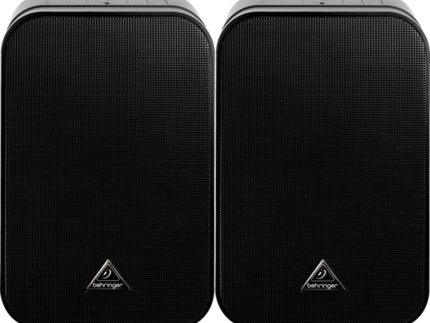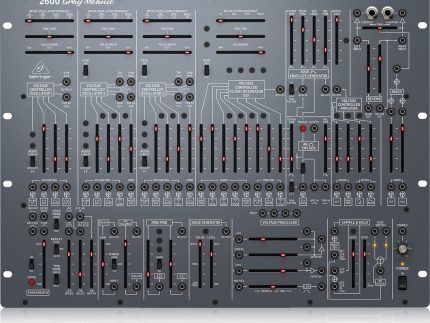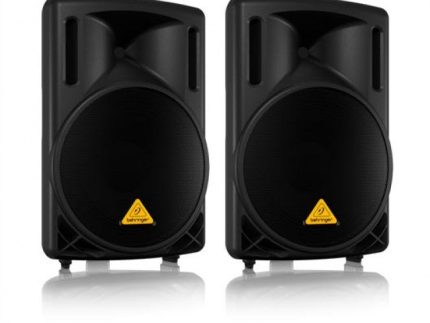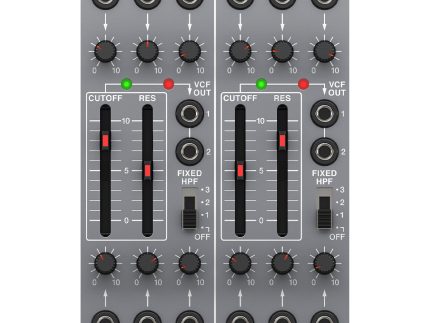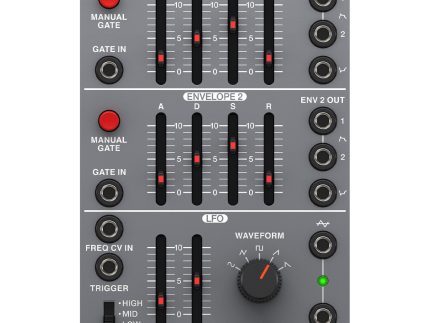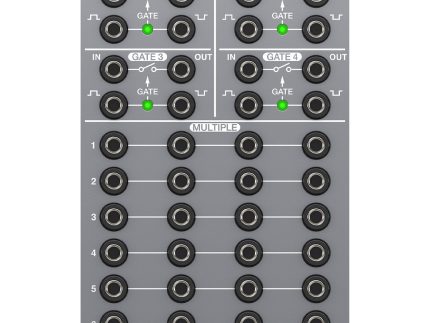Behringer 2600 Blue Marvin Analog Synth 8U Rack-Mount Format
Product Information
2600 Blue Marvin
The 1970s was a time when synthesizers were truly coming into their own as more and more musicians were adopting the instrument and making music that no one had ever heard before. Earlier synthesizers were massive and sophisticated devices that cost thousands of dollars, but in 1971, Alan R. Pearlman and Dennis Colin sought to create a more portable version of their huge ARP 2500 modular synth which they could market more towards musicians. Out of this concept came the ARP 2600 semi-modular synthesizer which became an instant hit and was quickly adopted by lots of renowned musicians including Edgar Winter, Pete Townshend, Herbie Hancock and Jean-Michel Jarre, to name a few. Soon after the first models were released, ARP made a bright blue version of Model 2600 called the “Blue Marvin”, named after ARP CFO Marvin Cohen.
Now meet the Behringer 2600 BLUE MARVIN, a limited edition, ultra-affordable and even more feature-packed homage to the iconic ARP 2600 synthesizer. Compared to the original Behringer 2600, the BLUE MARVIN features a mechanical spring reverb, hand-picked components, uni-color LEDs on each fader plus a super slick paint job that’ll make your setup pop! Conjure up virtually any sound imaginable with incredible finesse and ease. The pure analog signal path is based on the authentic ARP 2600 circuitry from the ’70s with matched transistors and JFETs. Owning a BLUE MARVIN is like having your piece of history enabling you to re-create timeless classics or forge your own musical path.
True to the Original
Great care has been taken in engineering the BLUE MARVIN’s true-to-the-original analog circuitry, semi-modular architecture and triple VCO design, all of which come together to recreate the classic tones evocative of classic electronic music. This highly-focused attention to detail gives the BLUE MARVIN its ultra-flexible sound-shaping capability, which then empowers you to recreate amazing tones – from super-fat bass and tasty leads, all the way to full-on dreamy ambience from the far reaches of your imagination.
Big, Fat Tones
The synthesizer tracks laid down in the 1970s and ’80s in progressive rock, wave and synth-pop have become classics and have inspired many other artists. The BLUE MARVIN lets you recreate all that magic – or design some incredible and original sounds that will make you a legend in your own right!
Ready to Rock
Just like the original, the BLUE MARVIN is a semi-modular synthesizer that allows you to start making music without having to plug patch cables into different modules. But don’t let that stop you, the BLUE MARVIN also features 93 patchable ins and outs, so you can configure the synthesizer any way you want.
Make Waves
The BLUE MARVIN features 3 VCOs with FM inputs. You can even patch the VCOs’ default waveforms to square, triangle, saw, sine or pulse which allows for an awe-inspiring palette of tonal possibilities. Any of the VCOs can also be switched to operate as a low frequency oscillator while the multi-mode VCF acts as the VCO mixer of the BLUE MARVIN where VCO’s one, two and three can be blended. Combine that with its integrated resonance control, filter mode switch and the ability to output to other areas of the synth and the BLUE MARVIN becomes a fantastic and flexible tool for creating a diverse palette of tones that will truly blow away your audience.
The Cherry on Top
To top off the already amazing array of waveforms and mixing capabilities of the BLUE MARVIN, an incredible range of modules and effects are at your disposal including a ring modulator, lag processor, sample and hold, Schmitt trigger, envelope follower, a noise generator with continuously variable color and even a mechanical spring reverb to add spaciousness and a sense of scale to your music. We’ve even included 2 dedicated LFOs with pulse and sine wave outputs.
Time to Attack
With the integrated ADSR and AR envelope generators of the BLUE MARVIN, you can create some truly dynamic progressions in your songs. Set the Attack, Decay, Sustain and Release low to get short and softer sounding notes then slowly slide the faders up; opening your notes to give your song some tension before that big drop everyone’s been waiting for. If simple ADSR controls are not enough, then you can get even more creative by flipping the Time Factor switch to either x2, x1 or x0.5. This control gives you more control over the shape of the envelope, so you can have notes that are short and percussive or long and atmospheric.
Shape Your Tone
The VCA section of the BLUE MARVIN offers even more tone-shaping possibilities alongside the VCF which can then be blended in the Mixer section. Within the VCA section, you can set the initial gain of the circuit and route signals to any of the input jacks and adjust the gain using the sliders. The VCA also features differential inputs for both linear and exponential response which accept control voltage signals via 3.5 mm jacks.
Controls and Connectivity
We just can’t help ourselves – like you, we’re gear heads too! So for those who want the numbers, the BLUE MARVIN has 78 faders and buttons, all laid out in a highly-intuitive format that puts the joy back into your music creation.
Unleash Your Imagination
When it comes to recreating the classic sounds of a classic era like the 1970s and ’80s, with a few modern features, there’s nothing like the Behringer 2600 BLUE MARVIN; portable and so very affordable.
Visit your dealer to experience the amazing 2600 BLUE MARVIN or get yours online today!
A Brief History of Analog Synthesis
The modern synthesizer’s evolution began in 1919, when a Russian physicist named Lev Termen (also known as Léon Theremin) invented one of the first electronic musical instruments – the Theremin. It was a simple oscillator that was played by moving the performer’s hand in the vicinity of the instrument’s antenna. An outstanding example of the Theremin’s use can be heard on the Beach Boys iconic smash hit “Good Vibrations”.
Ondioline
In the late 1930s, French musician Georges Jenny invented what he called the Ondioline, a monophonic electronic keyboard capable of generating a wide range of sounds. The keyboard even allowed the player to produce natural-sounding vibrato by depressing a key and using side-to-side finger movements. You can hear the Ondioline on Del Shannon’s “Runaway”.
Storytone Piano
Designed by famous piano manufacturer Story & Clark in association with RCA, the Storytone piano debuted at the 1939 New York World’s Fair. Hailed as the world’s first electric piano, the Storytone is prized by musicians and collectors alike for its realistic piano sound – only 500 or so were ever built.
Mellotron
Finding a high level of acceptance in the 1960s, Harry Chamberlin’s Mellotron was an electro-mechanical keyboard that generated sounds by playing back pre-recorded tape loops. Although tempermental and prone to pitch and mechanical issues, the Mellotron was used extensively by many U.K. artists. Classic tracks from the Moody Blues “Days of Future Passed”, the Beatles “Strawberry Fields Forever”, and the Rolling Stones “She’s a Rainbow” are prime examples. Attribute author: By Buzz Andersen from San Francisco, California, United States Mellotron | NAMM 2007
Minimoog
Designed to replace the large, modular synths being used in pop music at the time, Bill Hemsath and Robert Moog developed the Minimoog in 1971. The monophonic instrument became the first truly all-in-one, portable analog synthesizer. Thanks to its 3 oscillators and 24 dB/octave filter, the Minimoog produces an extremely rich and powerful bass sound and is still in high demand today. Yes keyboardist Rick Wakeman said the instrument “absolutely changed the face of music.” Attribute author: glacial23 – Early Minimoog Uploaded by clusternote, CC BY-SA 2.0
Yamaha CS-80
In 1976, Yamaha released their CS-80 8-voice polyphonic synthesizer, which provided velocity-sensitive keys and aftertouch that worked on individual voices. The analog instrument featured a ribbon controller, which allowed the user to perform polyphonic pitch bends and smooth glissandos. Composer Vangelis used the CS-80 extensively in the Blade Runner and Chariots of Fire soundtracks. The CS-80 also provided the bass line heard in the BBC 1980 series Doctor Who theme song. Image attribution: Pete Brown from Gambrills, MD, USA (DSC00539) [CC BY 2.0 (http://creativecommons.org/licenses/by/2.0)], via Wikimedia Commons.
Sequential Circuits Prophet 5
Sequential Circuits introduced the Prophet 5, which was the first analog 5-voice polyphonic synthesizers to provide onboard memory storage of all patch settings for instant recall. The great-sounding Prophet 5 revolutionized the synthesizer world and, in spite of its rather expensive price tag, became one of the most successful synths of all time. Designed by Dave Smith and J owen, the Prophet 5 was the keyboard of choice by a very long list of performers that includes Peter Gabriel, Philip Glass, Journey, The Cars, Thomas Dolby, Duran Duran, Gary Numan, Pink Floyd, and countless others. Image attribution: original uploader was Felix2036 at Dutch Wikipedia derivative work: Clusternote (Sequential_Circuits_Prophet_5.jpg) [Public domain], via Wikimedia Commons Which brings us to 1977…
A Passion for Keyboards
Our founder, Uli Behringer has a deep passion for keyboards. Born in the small town of Baden, Switzerland in 1961, Uli grew up in a musical family where his mother taught him to play the piano at the tender age of four. His father was a scientist who built a massive organ in the family home and taught the young lad all about electronics. So at the age of 17, Behringer built his first synthesizer – the UB-1. Later, while attending college to seek a degree in audio engineering, Uli put his electronics knowledge to use, building his own equalizers and signal processors to fill the gap left by the university’s inability to provide enough proper studio gear. Word soon spread about how good his products were, and he began building gear for his friends – the Behringer legacy had begun. The rest, as they say, is history…
-
Amazing analog synthesizer with triple VCO design allows for insanely fat music creation
-
Authentic reproduction of ultra-rare Arp Blue Marvin* circuitry from the 70s with matched transistors and JFETs
-
Semi-modular architecture requires no patching for immediate performance
-
3 VCOs, each with LFO mode, FM inputs and multiple wave-shape outputs for an awe-inspiring palette of tonal possibilities
-
Multi-mode VCF with dedicated low-pass output with additional switched high/notch output
-
Incredible range of modules including ring modulator, lag processor, sample & hold, Schmitt trigger, and envelope follower
-
ADSR and AR Envelope generators with switchable time factor
-
Fitted with a mechanical spring reverb for inspiring sound effects
-
Noise Generator with continuously variable color
-
2 dedicated LFOs with pulse and sine wave outputs
-
Switched Post Filter Distortion (PFD) / Inverter option on voltage processor
-
Differential (+/-) input VCA with both linear and exponential control inputs
-
Additional functions include attenuator, mixer, inverter, slew rate limiter and 4-way multiple for creative patching flexibility
-
External audio input for processing of external sound sources
-
58 Faders and 15 buttons give you hands-on direct and real time access to all parameters
-
83 Patch cable input/outputs for the ultimate in configuration flexibility
-
Comprehensive MIDI implementation with MIDI channel and Voice Priority selection
Specifications
Inputs
| VCO 1 / 2 / 3 | |
| Frequency modulation (FM) control |
11 x 3.5 mm TS jacks, CV range: -10 V to +10 V |
| Pulse width modulation (PWM) |
2 x 3.5 mm TS jack, CV range: -5 V to +5 V, 1 V/10% |
| VCF | |
| Audio |
5 x 3.5 mm TS jacks, 50 kΩ unbalanced |
| Control |
3 x 3.5 mm TS jacks, CV range: -10 V to +10 V |
| ADSR / AR envelope generator | |
| S&H clock |
1 x 3.5 mm TS jack, threshold: > 6 V |
| Gate in |
1 x 3.5 mm TS jack, threshold: +4 V |
| Trig in |
1 x 3.5 mm TS jack, threshold: +5 V |
| VCA | |
| Audio |
2 x 3.5 mm TS jacks, 50 kΩ unbalanced |
| Control (linear) |
1 x 3.5 mm TS jack, CV range: -10 V to +10 V |
| Control (exponential) |
1 x 3.5 mm TS jack, CV range: -10 V to +10 V |
| Mixer / reverb | |
| Audio |
2 x 3.5 mm TS jacks, 50 kΩ unbalanced |
| Left / right inputs |
2 x 3.5 mm TS jacks, 50 kΩ unbalanced |
| LFO | |
| Ext vib in |
1 x 3.5 mm TS jack, 50 kΩ unbalanced |
| Envelope follower | |
| Input |
1 x 3.5 mm TS jack, 100 kΩ unbalanced |
| Preamp input |
1 x 3.5 mm TS jack, 100 kΩ unbalanced |
| Ring modulator | |
| VCO 1 input |
1 x 3.5 mm TS jack, 100 kΩ unbalanced |
| VCO 2 input |
1 x 3.5 mm TS jack, 100 kΩ unbalanced |
| Voltage processor | |
| -10 V input |
1 x 3.5 mm TS jack, max. input level: +10 V |
| Inputs 1 / 3 / 5 |
3 x 3.5 mm TS jacks, max. input level: +10 V |
| Keyboard CV input |
1 x 3.5 mm TS jack, max. input level: +10 V |
| +10 V input |
1 x 3.5 mm TS jack, max. input level: +10 V |
| Env follower input |
1 x 3.5 mm TS jack, max. input level: +10 V |
| Sample & hold | |
| Noise gen input |
1 x 3.5 mm TS jack, 50 kΩ unbalanced |
| Ext clock in |
1 x 3.5 mm TS jack, threshold: > 3 V |
| Back panel | |
| Interval latch |
1 x ¼” TRS |
| Portamento footswitch |
1 x ¼” TRS |
Outputs
| VCO 1 / 2 / 3 | |
| Outputs (saw) |
3 x 3.5 mm TS jacks, 1 kΩ unbalanced |
| Outputs (pulse) |
3 x 3.5 mm TS jacks, 800 Ω unbalanced |
| Outputs (tri) |
2 x 3.5 mm TS jacks, 1 kΩ unbalanced (VCO 2 / 3 only) |
| Outputs (sine) |
2 x 3.5 mm TS jacks, 1 kΩ unbalanced (VCO 2 / 3 only) |
| VCF | |
| Outputs |
1 x 3.5 mm TS jack, 1 kΩ unbalanced |
| ADSR / AR Envelope Generator | |
| Output |
2 x 3.5 mm TS jacks, CV range: 0 V to +10 V |
| VCA | |
| Output |
1 x 3.5 mm TS jack, 1 kΩ unbalanced |
| Mixer / reverb | |
| Post-attenuator outputs |
2 x 3.5 mm TS jacks, 1 kΩ unbalanced |
| Post-mixer output |
1 x 3.5 mm TS jack, 1 kΩ unbalanced |
| L / R outputs |
2 x ¼” TS, 500 Ω unbalanced 2 x 3.5 mm TS jacks, 500 Ω unbalanced |
| LFO | |
| LFO (triangle) |
1 x 3.5 mm TS jack, 1 kΩ unbalanced |
| LFO (square) |
1 x 3.5 mm TS jack, 1.8 kΩ unbalanced |
| LFO delayed (sine) |
1 x 3.5 mm TS jack, 1 kΩ unbalanced |
| Envelope follower | |
| Output (preamp x1000 ) |
1 x 3.5 mm TS jack, max. output gain: +60 dBu |
| Output (preamp x100 ) |
1 x 3.5 mm TS jack, max. output gain: +40 dBu |
| Output (preamp x10 ) |
1 x 3.5 mm TS jack, max. output gain: +20 dBu |
| Output (env follower) |
1 x 3.5 mm TS jack, max. output level: +14 V |
| Ring modulator | |
| Output |
1 x 3.5 mm TS jack, output level: -10 V to +10 V |
| Noise generator | |
| Output |
1 x 3.5 mm TS jack, output level: -10 V to +10 V |
| Voltage processor | |
| Inverter 1 output |
1 x 3.5 mm TS jack, output level: -10 V to +10 V |
| Inverter 2 output |
1 x 3.5 mm TS jack, output level: -10 V to +10 V |
| Lag output |
1 x 3.5 mm TS jack, output level: -10 V to +10 V |
| Sample & hold | |
| Internal clock out |
1 x 3.5 mm TS jack, max. output level: +10 V |
| S/H out |
1 x 3.5 mm TS jack, max. output level: +14 V |
| Portamento / keyboard | |
| Trig out |
1 x 3.5 mm TS jack, output level: +14 V |
| Upper voice |
1 x 3.5 mm TS jack, max. output level: +10 V |
| Gate out |
1 x 3.5 mm TS jack, output level: +10 V |
| Keyboard CV output |
1 x 3.5 mm TS jack, max. output level: +7 V |
| Phones | |
| Type |
1 x 1/8″ TRS jack, stereo |
| Max. output level |
5 dBu |
| Output impedance |
8 Ω |

